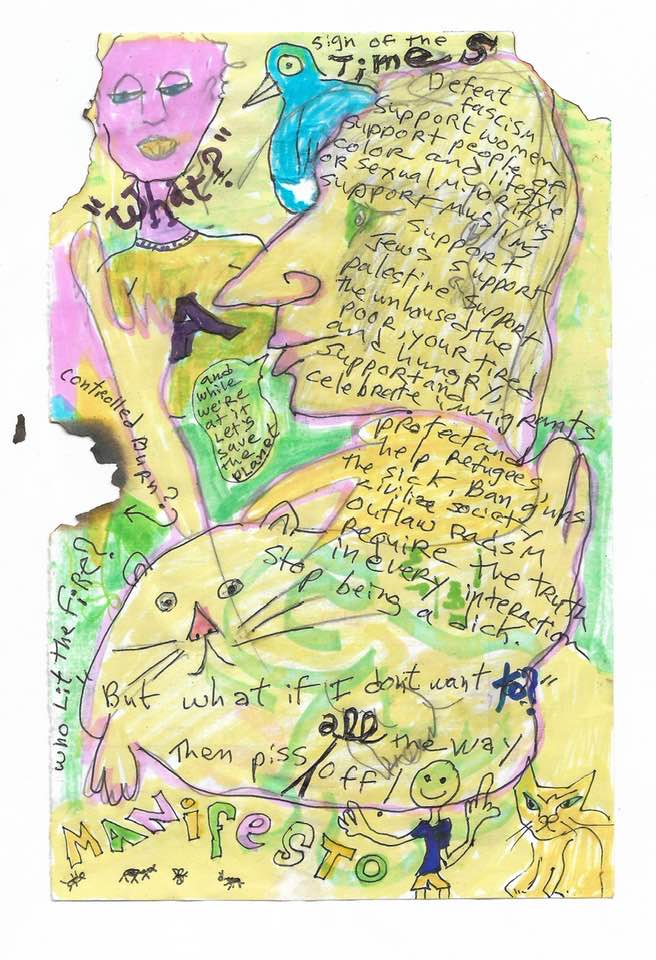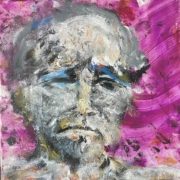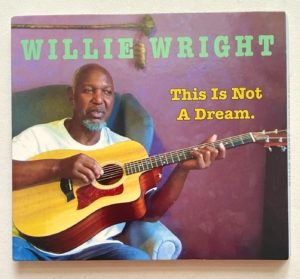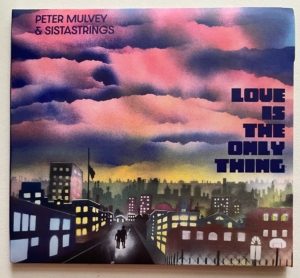BillyBob Green-Coil: a Lesson in Community
Looking for the Crossroads Number 13
 For me, this story starts with the cover of Vance Gilbert’s latest album, The Mother of Trouble. I was fascinated by the intense, whimsical art (which is a good way to describe Vance’s music, too.) The more I learned about the artist, BillyBob Green-Coil, the more intrigued I became. The artist is actually a two-headed force of creativity deeply rooted in family and folk community. As layers of conversation unfolded through emails…well, let me just show you.
For me, this story starts with the cover of Vance Gilbert’s latest album, The Mother of Trouble. I was fascinated by the intense, whimsical art (which is a good way to describe Vance’s music, too.) The more I learned about the artist, BillyBob Green-Coil, the more intrigued I became. The artist is actually a two-headed force of creativity deeply rooted in family and folk community. As layers of conversation unfolded through emails…well, let me just show you.
Bob: This partnership started as a friendship. About four years later it had evolved into a romantic relationship and not long after we began living together and raising my child together, in partnership with her mother. Our daughter is now 52 (she was five at the time.)
The first thing we made together was a sandbox for her to play in; the second thing was a table. Then we bought a 26-acre deserted hill farm, past power lines, phone and plumbing etc. The next thing we built was a shed to go with an existing cabin and we moved into that with the five-year-old while we spent two years building a huge house without power tools: cinderblock foundation 24’ x 32’ two full storeys. Everything we did involved making something together: chicken coops, fences, a sty for the pigs, pens for the goats. We were also dead broke and had minimum wage jobs, so cars had to be fixed – everything we did we did ourselves.
Bill: For me, the creative part has always been perplexing because I deal with shyness and don’t want either either criticism or praise; both things inhibit my creativity. So working with someone, I’m able to totally let go of that as if I’m working with a ghost writer.
So working with someone, I’m able to totally let go of that as if I’m working with a ghost writer.
Bob: We’d each already been painters. During his father’s military service, Bill lived in Germany as a child; his mother was getting a masters in art history. He grew up in Frankfort as a welcome frequent guest in the homes and salons of some of the surviving pioneers of the German Expressionist movement. After the family returned to the U.S., Bill rented studio space of his own by age 16.
My art background included a stint as a design artist in the textile industry in NYC. As a younger artist I had access to the full ferment of the New York art scene of the 50s and 60s, and was blessed with a high school art teacher who was friendly with Lee Krasner and other at the time relatively unknown art figures. They were frequent visitors to our class and critiqued our work.
Bill: We’ve always worked well together without conflict or being at cross purposes about almost anything. Our compatibility is seemingly natural, not exactly something we have to work at, but it has created an enormous space within which we support each other‘s achievements artistic and otherwise.
Bob: As far as the art team itself, during our careers, Bill was a licensed massage therapist and I was a clinical mental health counselor. We practiced together for over 30 years and during that time neither of us did much art. I painted fewer than 10 paintings a year and Bill fewer than that probably.
Bill: Once we retired in 2011 and moved out of our area (Vermont) to Palm Springs (California), saw the new vistas and new cultures in Palm Springs, we had new stimulation and also the free time that was necessary to nourish creativity. We started making art together.
Bob: During the working years, I had one particularly creative year which was 1981. I probably did 30 paintings, but in each case Bill would help: I would be having trouble with a feature if it was a portrait or something and he would either advise or pick up a brush and revise, but we were still somehow thinking of them as my paintings. At one point just after we retired, I was doing a very large abstract and I just couldn’t get something right about it and Bill kept telling me what to do and telling me what to do and finally I gave him the brush and I said, “You do it.”
He finished the painting, and that was the first “BillyBob.”
me: How did you start designing album covers? (click on each image for a better view)
BillyBob: The first one we did was for an EP released by Erik Kaarla called “Parade.” The second was for album “This is Not a Dream” which we made with lifelong friend Willie Wright. It was, in Willie‘s words, “a family type album.” We created our own label, Green Coil Records, and used CD Baby as the manufacturer. They give you the tools to design your own cover so we did.
The next one happened almost by accident: We did a painting of a horse while up in Montréal. Our friends George and Jess, who formed the folk duo Strangled Darlings, fell in love with the painting. They bought it and then asked to use it as their album cover for “American Pageant.”
The fourth one, our son-in-law Peter Mulvey asked us to do an album cover based on an image that had formed in his mind so he became the third collaborator. He described the image and we produced it over several months and many, many, many versions. That became the cover of “Love is The Only Thing.” The fifth cover is a doodle one of us did of Vance Gilbert, who is a friend of Peter’s. We sent him a copy and he liked it and asked if he could use it for an album cover and we said yes. The sixth, now in the planning stage, will be for another EP by Erik Kaarla, a member of the musical family (who also plays on Willie Wright’s album.)

Each one was spontaneous and unique. With Parade it came about because we were showing Erik some photographs one of us had taken in the 60s. He asked if we knew how to use a computer to superimpose words on a picture so the conversation was really about the use of a computer for graphics which in 1995 was pretty primitive compared to now. But the conversation probably started because Erik is a friend that we’ve known and played music with for decades. He was doing this project on his own so he asked the two artists he was close to.
Second thought answer: we never were and still aren’t particularly interested in doing album covers as a thing. Our answer to almost any proposal to do art in almost any context is “yes” if we feel any connection or inspiration. The spirit of Kuumba is the engine.
me: What is the spirit of Kuumba?
BillyBob: Not super knowledgeable about Kwanzaa, but a musical and theater artist friend in Boston, Verna Hampton, introduced us a few years ago to the principle of Kuumba as the Spirit of Creativity, and it spoke to us, and rang true, especially in that it extends artistic endeavors beyond the esthetic to the social and moral.
“Creativity means to perform acts that leave our community more beautiful and beneficial than we inherited it.” – Dr. Maulana Karanga
It seems to fit with some ideas about the Muses, and other feelings people express about where creativity comes from.
me: but what about music?
BillyBob: Bob and Bill have always played music together, starting 50ish years ago with drums, logs, sticks found at waterfalls. Many of our friends are musicians, as is our son-in-law, and we are happy to play as kitchen amateurs. We did gear up as professionals to make the Willie Wright album, with Bob playing rhythm guitar on most tracks (lead on “Trust”) and Bill producing, keeping the group on beat and engineering three of the tracks.
This is Bill & Bob + Erik Kaarla on the eve of Bob’s then-dreaded hernia surgery in around 2015.
this is Bob singing a co-written Billybob lyric:
Bob: One more art form: When You Remember Deir Yassin– a collection of poems by R. L. Green, an American Jewish writer, on the subject of the occupation and destruction of Palestine. The poems are offered in the original English with translations into Arabic by Mousa Ishaq and Kristen Peterson-Ishaq.

me: OMGGGGG NO! Yes! Can you tell me briefly about this project? What are your thoughts behind translating into Arabic? Is the cover your work also? Tell me about that, please.
Bob: I am from the same family which produced David Ben-Gurion, and contributed in other ways to the establishment of Israel. The poems express my to Palestine; I see Zionism as a colossal mistake, which has lead directly to crimes against humanity. My late father, previously a committed Zionist who smuggled funds into the hands of Jewish paramilitaries in the 1930’s, in his 90’s, renounced his support for that colonial ideology in favor of self-determination and freedom for Occupied Palestine.
The cover was done by living legend Peter Schumann, founder and still director of Bread & Puppet.
 BillyBob: One funny/not funny hint about creativity, spoken out of the blue for no obvious reason and with no forewarning by the previously silent taxi driver at the end of a 2am ride to the Bronx in 1966:
BillyBob: One funny/not funny hint about creativity, spoken out of the blue for no obvious reason and with no forewarning by the previously silent taxi driver at the end of a 2am ride to the Bronx in 1966:
“Kid, personality is a psychic disease; Art is spiritual disease.”
I rest my case.
P. S. Our 22 month old grandson now calls us “Bobbybeebee and Bop” so we have signed our latest piece that way, a re-purposed piece of old tourist art which is in honor of, and on its way to, Café Carpe in Ft. Atkinson, Wisconsin, a legendary folk venue which gave Peter his start 30+ years ago.
You can follow BillyBob Green-Coil on Facebook or peruse their website here: billybobpaintings

BillyBob Green-Coil: a Lesson in Community
Looking for the Crossroads Number 13


















